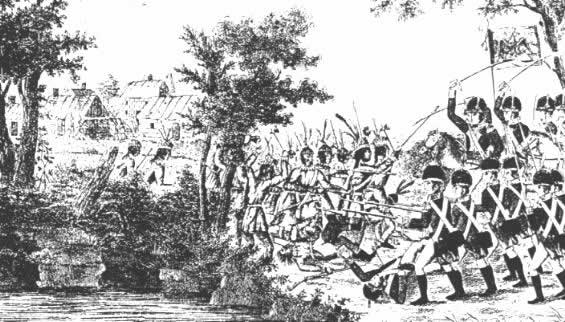Battle of Autossee

David Crockett SCOUT SMALL BOY, PILGRIM, MOUNTAINEER, SOLDIER, BEAR-HUNTER, AND CONGRESSMAN DEFENDER OF THE ALAMO
The Battle of Autossee (meaning “war club”) took place on November 29, 1813, during the Creek War, at the Creek towns of Autossee and Tallasee near present-day Shorter, Alabama in Macon County Alabama.
General John Floyd, with 900 to 950 militiamen and 450 allied Creek, attacked and burned down both villages, killing 200 Red Sticks in the process.
As Andrew Jackson, John Coffee and John Cocke made their way south from Tennessee with a force of 3,500 men, Floyd set out along the Federal Road for Autossee, a village of about 1,500 Creek (which included High Head Jim and others responsible for the massacre at Fort Mims). His company included 900 militiamen and 450 allied Creek, many from Tukabatchee, under the command of William McIntosh.
Before sunrise, the Georgia militia split into two columns in an effort to surround the town. Three things, however, did not go as planned before the attack could commence. First, Floyd discovered a second, smaller Red Stick town, Tallasee (“Apple Grove”), forcing him to order the company to spread out thinner than he wanted. Also, a western escape route had not been blocked by McIntosh because he and his men could not cross the freezing, deep Tallapoosa River. They had settled for crossing Calebee Creek and blocking the north. Lastly, and most critically, a Red Stick hunter spotted and warned the town, allowing them time to evacuate women and children and to call for nearby help (which did not come).[4]
Floyd’s men had superior musketry and cannon, which allowed them to storm the village and set it ablaze. Although most enemy Creek warriors fled, Floyd later reported that some stayed to fight to the end, dying in the fires.
In three hours, 200 to 250 Red Sticks were killed (among whom were the Autossee and Tallasee kings). Most of the townspeople had escaped, however, due to the militia’s thinly spread formation and ill-placed allied Creek. Floyd lost 11 of his men by comparison (and a small number of allied Creek), with five wounded including himself.[5] Between the two towns, 400 houses were burned to the ground.[6]
Now low on supplies, the militia headed back to Fort Mitchell and regrouped for another offensive which would result in the Battle of Calebee Creek. Paddy Walsh, late to help his comrades at Autossee, harassed them along the way, killing an additional five men.[4]
The site of Autossee now lies on private property in Macon County, Alabama, near the town of Shorter. The location is unmarked and inaccessible to the public.[2]
References
- https://geonames.usgs.gov/apex/f?p=gnispq:3:0::NO::P3_FID:158140
- Jump up to: a b “Battle of Autossee”. Retrieved 3 March 2017.
- ^ Jump up to: a b Halbert, Henry Sale; Ball, Timothy Horton (1895). The Creek War of 1813 and 1814. Montgomery, AL: White, Woodruff, & Fowler. p. 273.
- Jump up to: a b c d “Battle of Autossee”. Encyclopedia of Alabama. 19 May 2011. Retrieved 3 March 2017.
- Note: He had been hit by a musket ball in the knee in the midst of battle.
- Drake, Samuel G.; Williams, H.L. (1880). The Aboriginal Races of North America. New York: Hurst & Company. p. 391.
Source: Wikipedia contributors, “Battle of Autossee,” Wikipedia, The Free Encyclopedia
